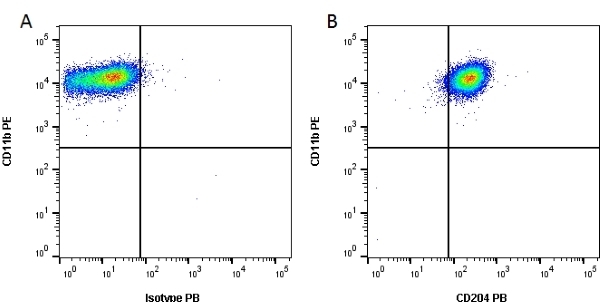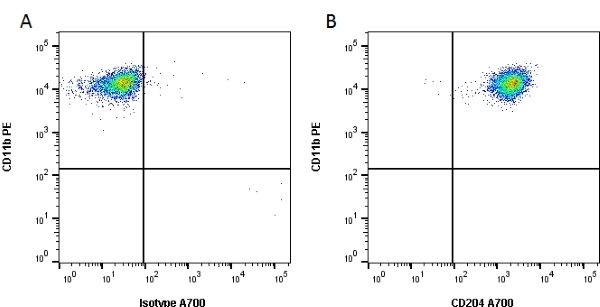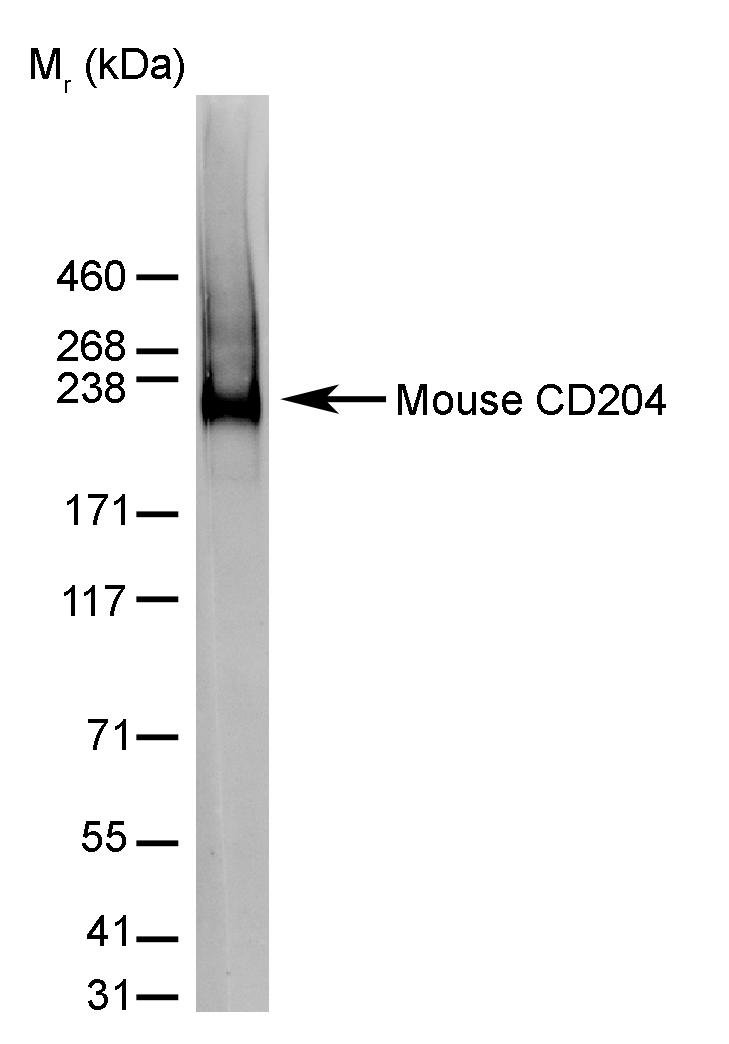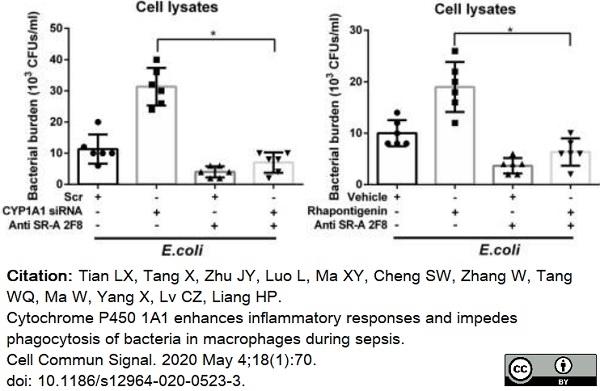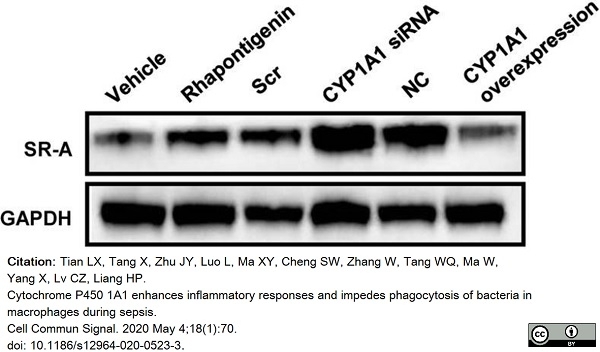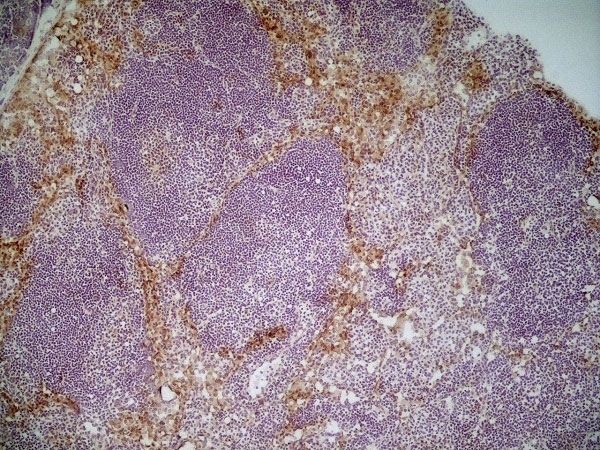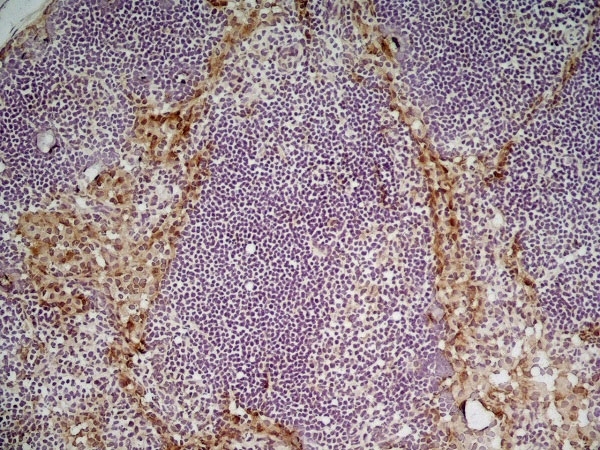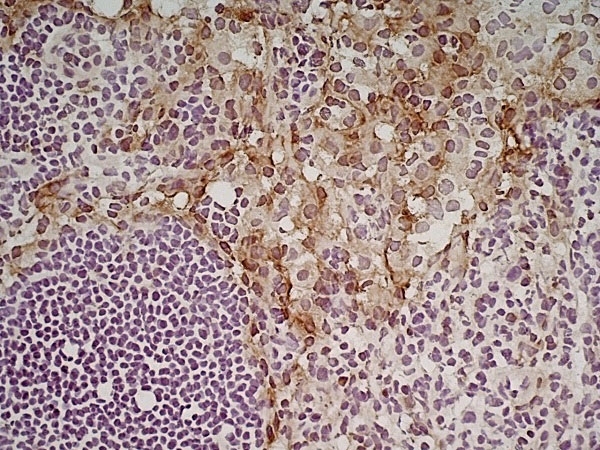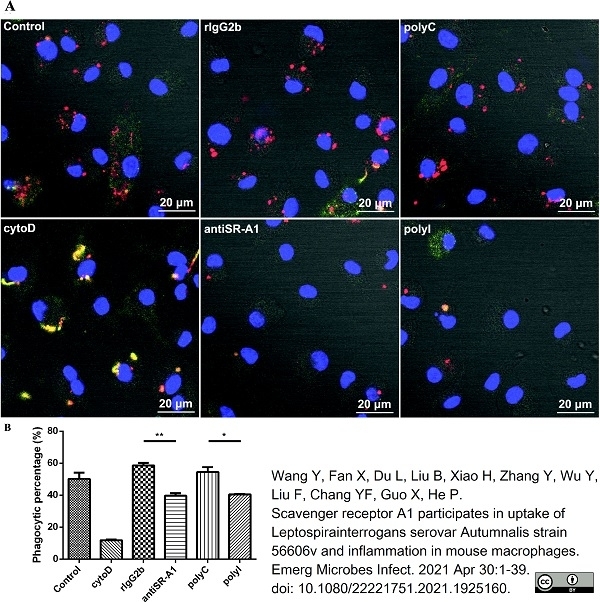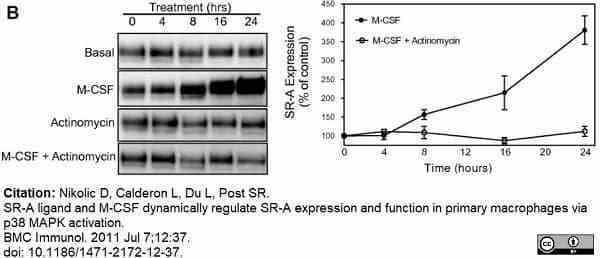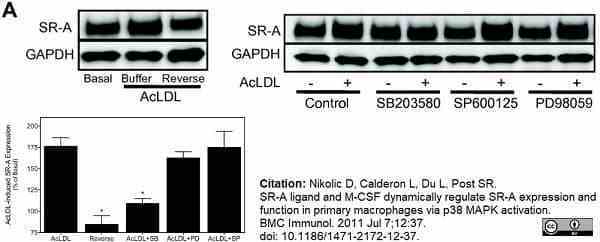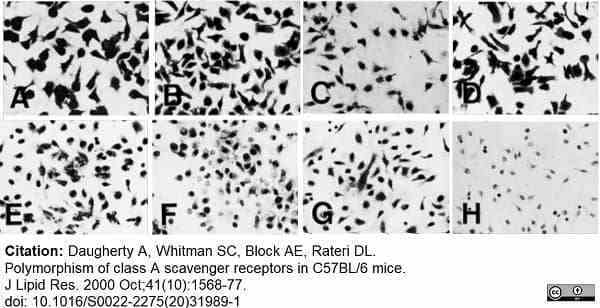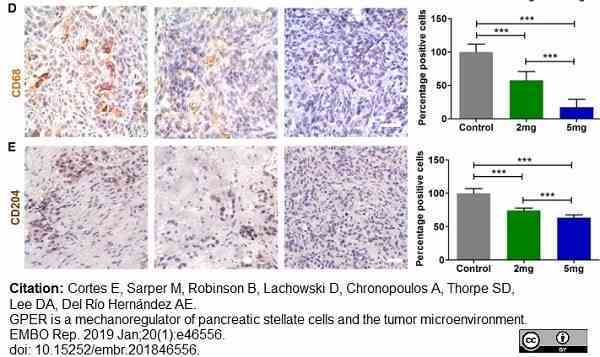CD204 antibody | 2F8














Rat anti Mouse CD204
- Product Type
- Monoclonal Antibody
- Clone
- 2F8
- Isotype
- IgG2b
- Specificity
- CD204
| Rat anti Mouse CD204 antibody, clone 2F8 recognizes the murine scavenger receptor class A (SR-A), type I and II, also known as CD204. CD204 is expressed by tissue macrophages and functions both as an endocytic receptor for lipoproteins and as an adhesion receptor for macrophages binding to ligand rich tissues e.g. atherosclerotic lesions. Rat anti Mouse CD204 antibody, clone 2F8 inhibits the uptake of acetylated low-density lipoproteins and also inhibits divalent cation independent adhesion (Fraser et al. 1993). Rat anti Mouse CD204 antibody, clone 2F8 recognizes an epitope within SRA that is polymorphic in the SRA from C57BL/6 mice. Rat anti Mouse CD204 antibody, clone 2F8 is therefore unsuitable for use with the C57BL/6 mouse strain (Daugherty et al. 2000). |
- Target Species
- Mouse
- Species Cross-Reactivity
-
Target Species Cross Reactivity Pig Channel catfish - N.B. Antibody reactivity and working conditions may vary between species.
- Product Form
- Purified IgG - liquid
- Preparation
- Purified IgG prepared by affinity chromatography on Protein G from tissue culture supernatant
- Buffer Solution
- Phosphate buffered saline
- Preservative Stabilisers
- 0.09% sodium azide (NaN3)
- Carrier Free
- Yes
- Immunogen
- Raw 264 cell line
- Approx. Protein Concentrations
- MCA1322T, MCA1322: IgG concentration 1.0 mg/ml
- MCA1322GA: IgG concentration 1 mg/ml
- Fusion Partners
- Spleen cells from immunized AO rats were fused with cells of the Y3 rat myeloma cell line
- Regulatory
- For research purposes only
- Guarantee
- 12 months from date of despatch
Avoid repeated freezing and thawing as this may denature the antibody. Storage in frost-free freezers is not recommended.
| Application Name | Verified | Min Dilution | Max Dilution |
|---|---|---|---|
| ELISA | |||
| Flow Cytometry | 1/50 | 1/100 | |
| Immunofluorescence | |||
| Immunohistology - Frozen 1 | |||
| Immunohistology - Paraffin | |||
| Immunohistology - Resin | |||
| Immunoprecipitation | |||
| Western Blotting 2 |
- 1The epitope recognised by this antibody is reported to be sensitive to formaldehyde fixation and tissue processing. Bio-Rad recommends the use of acetone fixation for frozen sections.
- 2This product recognises CD204 in J774 cells under non-reduced conditions only.
- Flow Cytometry
- Use 10μl of the suggested working dilution to label 106 cells in 100μl
References for CD204 antibody
-
Fraser, I. et al. (1993) Divalent cation-independent macrophage adhesion inhibited by monoclonal antibody to murine scavenger receptor.
Nature. 364 (6435): 343-6. -
de Villiers, W.J. et al. (1994) Macrophage-colony-stimulating factor selectively enhances macrophage scavenger receptor expression and function.
J Exp Med. 180 (2): 705-9. -
Hughes, D.A. et al. (1994) Murine M phi scavenger receptor: adhesion function and expression.
Immunol Lett. 43 (1-2): 7-14. -
Hughes, D.A. et al. (1995) Murine macrophage scavenger receptor: in vivo expression and function as receptor for macrophage adhesion in lymphoid and non-lymphoid organs.
Eur J Immunol. 25 (2): 466-73. -
Daugherty, A. et al. (2000) Polymorphism of class A scavenger receptors in C57BL/6 mice.
J Lipid Res. 41 (10): 1568-77. -
Kaur, H. et al. (2003) Identification of a scavenger receptor homologue on nonspecific cytotoxic cells and evidence for binding to oligodeoxyguanosine.
Fish Shellfish Immunol. 15: 169-81. -
Kaur, H. et al. (2004) Single-base oligodeoxyguanosine-binding proteins on nonspecific cytotoxic cells: identification of a new class of pattern-recognition receptors.
Scand J Immunol. 60: 238-48. -
Allred, K.F. et al. (2006) Estrogen receptor-alpha mediates gender differences in atherosclerosis induced by HIV protease inhibitors.
J Biol Chem. 281:1419-25.
View The Latest Product References
-
Anatelli, F. et al. (2006) Macrophage-targeted photosensitizer conjugate delivered by intratumoral injection.
Mol Pharm. 3: 654-64. -
Luechtenborg, B. et al. (2008) Function of scavenger receptor class A type I/II is not important for smooth muscle foam cell formation.
Eur J Cell Biol. 87: 91-9. -
Nielsen, B.S. et al. (2008) Matrix metalloproteinase 13 is induced in fibroblasts in polyomavirus middle T antigen-driven mammary carcinoma without influencing tumor progression.
PLoS One. 3 (8): e2959. -
Aid, S. et al. (2008) Neuroinflammatory response to lipopolysaccharide is exacerbated in mice genetically deficient in cyclooxygenase-2.
J Neuroinflammation. 5: 17. -
Neyen, C. et al. (2009) Macrophage scavenger receptor A mediates adhesion to apolipoproteins A-I and E.
Biochemistry. 48 (50): 11858-71. -
Moldenhauer, L.M. et al. (2010) GM-CSF is an essential regulator of T cell activation competence in uterine dendritic cells during early pregnancy in mice.
J Immunol. 185 (11): 7085-96. -
Cainarca, S. et al. (2010) A photoprotein in mouse embryonic stem cells measures Ca2+ mobilization in cells and in animals.
PLoS One. 5: e8882. -
Dewals, B.G. et al. (2010) IL-4Ralpha-independent expression of mannose receptor and Ym1 by macrophages depends on their IL-10 responsiveness.
PLoS Negl Trop Dis. 4(5):e689. -
Swain, S.D. et al. (2011) Pneumocystis infection in an immunocompetent host can promote collateral sensitization to respiratory antigens.
Infect Immun. 79 (5): 1905-14. -
Hald, A. et al. (2011) MMP9 is protective against lethal inflammatory mass lesions in the mouse colon.
Dis Model Mech. 4: 212-27. -
Nikolic, D. et al. (2011) SR-A ligand and M-CSF dynamically regulate SR-A expression and function in primary macrophages via p38 MAPK activation.
BMC Immunol. 12: 37. -
Sever-Chroneos, Z. et al. (2011) Surfactant Protein A (SP-A)-mediated Clearance of Staphylococcus aureus Involves Binding of SP-A to the Staphylococcal Adhesin Eap and the Macrophage Receptors SP-A Receptor 210 and Scavenger Receptor Class A.
J Biol Chem. 286: 4854-70. -
Zaynagetdinov, R et al. (2011) A critical role for macrophages in promotion of urethane-induced lung carcinogenesis.
J Immunol. 187 (11): 5703-11. -
Yang, C.N. et al. (2011) Mechanism mediating oligomeric Aβ clearance by naïve primary microglia.
Neurobiol Dis. 42 (3): 221-30. -
Horlad, H. et al. (2013) Corosolic acid impairs tumor development and lung metastasis by inhibiting the immunosuppressive activity of myeloid-derived suppressor cells.
Mol Nutr Food Res. 57 (6): 1046-54. -
Koronyo Y et al. (2015) Therapeutic effects of glatiramer acetate and grafted CD115+ monocytes in a mouse model of Alzheimer's disease.
Brain. 138 (Pt 8): 2399-422. -
Tao, J. et al. (2015) ClC-3 deficiency prevents atherosclerotic lesion development in ApoE-/- mice.
J Mol Cell Cardiol. 87: 237-247. -
Prins, J.R. et al. (2015) Unstable Foxp3+ regulatory T cells and altered dendritic cells are associated with lipopolysaccharide-induced fetal loss in pregnant interleukin 10-deficient mice.
Biol Reprod. 93 (4): 95. -
Almholt, K. et al. (2015) Spontaneous lung and lymph node metastasis in transgenic breast cancer is independent of the urokinase receptor uPAR.
Clin Exp Metastasis. 32 (6): 543-54. -
Verheijden S et al. (2015) Identification of a chronic non-neurodegenerative microglia activation state in a mouse model of peroxisomal β-oxidation deficiency.
Glia. 63 (9): 1606-20. -
Tsay, H.J. et al. (2016) Identifying N-linked glycan moiety and motifs in the cysteine-rich domain critical for N-glycosylation and intracellular trafficking of SR-AI and MARCO.
J Biomed Sci. 23: 27. -
Fujiwara, Y. et al. (2016) Onionin A, a sulfur-containing compound isolated from onions, impairs tumor development and lung metastasis by inhibiting the protumoral and immunosuppressive functions of myeloid cells.
Mol Nutr Food Res. 60 (11): 2467-80. -
Kokubu, Y. et al. (2016) Induction of protumoral CD11c(high) macrophages by glioma cancer stem cells through GM-CSF.
Genes Cells. 21 (3): 241-51. -
Sapkota, M. et al. (2016) Malondialdehyde-Acetaldehyde-Adducted Surfactant Protein Alters Macrophage Functions Through Scavenger Receptor A.
Alcohol Clin Exp Res. 40 (12): 2563-2572. -
Rentsendorj, A. et al. (2018) A novel role for osteopontin in macrophage-mediated amyloid-β clearance in Alzheimer's models.
Brain Behav Immun. 67: 163-180. -
Haupt, F. et al. (2019) Retinal myeloid cells regulate tip cell selection and vascular branching morphogenesis via Notch ligand Delta-like 1.
Sci Rep. 9 (1): 9798. -
Yamamoto, M. et al. (2019) Evaluation of neurobehavioral impairment in methylmercury-treated KK-Ay mice by dynamic weight-bearing test.
J Appl Toxicol. 39 (2): 221-30. -
Cortes, E. et al. (2019) GPER is a mechanoregulator of pancreatic stellate cells and the tumor microenvironment.
EMBO Rep. 20 (1): e46556. -
Tian, L.X. et al. (2020) Cytochrome P450 1A1 enhances inflammatory responses and impedes phagocytosis of bacteria in macrophages during sepsis.
Cell Commun Signal. 18 (1): 70. -
Li, S. et al. (2020) Activated Bone Marrow-Derived Macrophages Eradicate Alzheimer's-Related Aβ(42) Oligomers and Protect Synapses.
Front Immunol. 11: 49. -
Becerril-García, M.A. et al. (2020) Langerhans Cells From Mice at Birth Express Endocytic- and Pattern Recognition-Receptors, Migrate to Draining Lymph Nodes Ferrying Antigen and Activate Neonatal T Cells in vivo.
Front Immunol. 11: 744. -
Koronyo-Hamaoui, M. et al. (2020) Peripherally derived angiotensin converting enzyme-enhanced macrophages alleviate Alzheimer-related disease.
Brain. 143 (1): 336-58. -
Shiau, D.J. et al. (2020) Hepatocellular carcinoma-derived high mobility group box 1 triggers M2 macrophage polarization via a TLR2/NOX2/autophagy axis.
Sci Rep. 10 (1): 13582. -
Wang, Y. et al. (2021) Scavenger receptor A1 participates in uptake of Leptospira interrogans serovar Autumnalis strain 56606v and inflammation in mouse macrophages.
Emerg Microbes Infect. : 1-39. -
Mañucat-Tan, N. et al. (2021) Hypochlorite-induced aggregation of fibrinogen underlies a novel antioxidant role in blood plasma.
Redox Biol. 40: 101847. -
Jia, J. et al. (2022) Ferritin triggers neutrophil extracellular trap-mediated cytokine storm through Msr1 contributing to adult-onset Still's disease pathogenesis.
Nat Commun. 13 (1): 6804. -
Zhang, H. et al. (2024) Ferritin-mediated neutrophil extracellular traps formation and cytokine storm via macrophage scavenger receptor in sepsis-associated lung injury.
Cell Commun Signal. 22 (1): 97.
Further Reading
-
Gordon, S. (1995) The macrophage.
Bioessays. 17 (11): 977-86.
- Synonyms
- Scavenger Receptor Type I/II
- RRID
- AB_322413
- UniProt
- P30204
- Entrez Gene
- Msr1
- GO Terms
- GO:0005515 protein binding
- GO:0016021 integral to membrane
- GO:0005044 scavenger receptor activity
- GO:0006898 receptor-mediated endocytosis
- GO:0010744 positive regulation of macrophage derived foam cell differentiation
- GO:0010886 positive regulation of cholesterol storage
- GO:0030169 low-density lipoprotein particle binding
- GO:0030301 cholesterol transport
- GO:0034362 low-density lipoprotein particle
- View More GO Terms
- GO:0034381 plasma lipoprotein particle clearance
- GO:0042953 lipoprotein transport
Please Note: All Products are "FOR RESEARCH PURPOSES ONLY"
View all Anti-Mouse ProductsAlways be the first to know.
When we launch new products and resources to help you achieve more in the lab.
Yes, sign me up